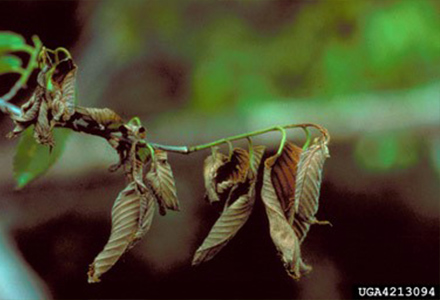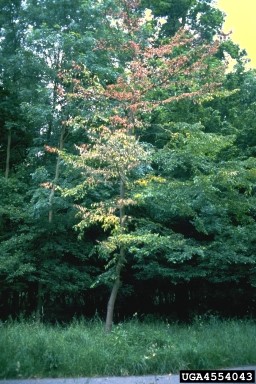PLANT PEST

commonly planted in Australian cities and gardens.
Minnesota Department of Natural Resources, Bugwood.org
Dutch elm disease
Exotic to Australia
Features: One of the most devastating plant diseases in the
world that targets elm tree species
Where it's from: Europe, North America, parts of Asia,
New Zealand
How it spreads: Importation of infected plants, timber and
wood products; local spread by bark beetle vectors, transport
of infected plants or timber, root grafts between trees,
infected bark mulch
At risk: Elm trees in our cities, parks and gardens; garden
and nursery industry
This pest is listed on both the National Priority Plant Pests and the National Priority List of Exotic Environmental Pests, Weeds and Diseases as it has the potential for significant plant industry/agriculture impacts and may also cause significant damage to our environment and social amenity.
Keep it out
Dutch elm disease is caused by a fungus (Ophiostoma novo-ulmi and also Ophiostoma ulmi) that has destroyed huge numbers of elm trees in North America, Europe and parts of Asia.
In some parts of Europe it is estimated that 60-70 per cent of trees have died. It is a wilting disease that is spread by the European bark beetles (Scolytus multistriatus which has been present in Australia since 1974, and Scolytus scolytus). The beetle genus Hylurgopinus is also a vector in North America.
The disease and a bark beetle (Scolytus multistriatus) that spreads it are present in New Zealand which is a particular concern for Australia. At risk are our ornamental elm plantings and our garden and nursery industry.
Importing goods
Never ignore Australia’s strict biosecurity rules, so that we can keep Dutch elm disease out of Australia.
Import shipments may need to be treated and certified, so before you import, check our Biosecurity Import Conditions system (BICON).
What to look for
- Look for wilted and damaged elm trees.
- Symptoms vary depending on whether trees were infected through beetle feeding wounds or through root grafts.
- Where beetles are involved, trees show wilting, curling and yellowing of one or more branch tips at the top of the tree.
- Where a tree has been infected through root grafts, disease develops more rapidly, with wilting first appearing in the lower branches and progressing upwards.
- In young trees and seedlings there is wilting and curling of leaves within one week of infection; all leaves may curl and die after five weeks.

Where to look
Importers
Importation of infected plants, timber or wood products or European bark beetles carrying the disease are the most likely way that Dutch elm disease could make it to Australia.
Home gardeners
Look for progressive wilting and browning of elm trees.
What to do
If you think you’ve found symptoms on elm trees or elm timber or wood products:
- Take a photo
- Do not disturb the material (this may be as simple as closing the doors on a shipping container or covering a small tree in plastic).
